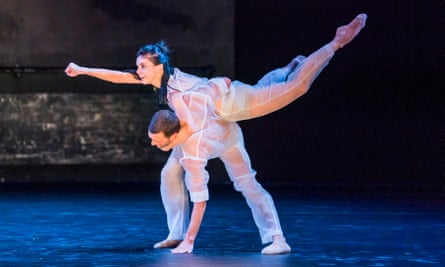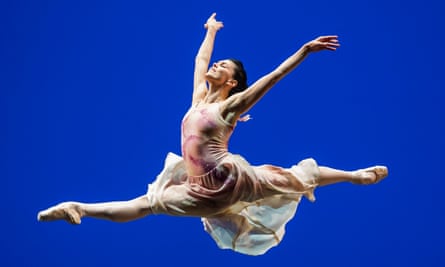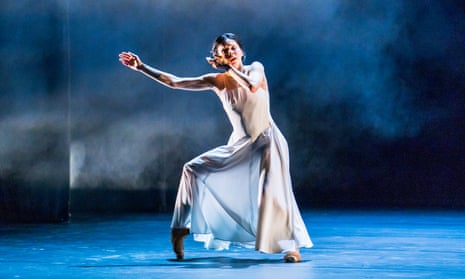Much is made these days of ballet dancers being flexible. Not ankles-up-by-your-ears flexible – although that helps – but stylistically flexible. You train for years moulding your body to fit classical ballet’s narrow prescription, then spend the rest of your dancing life breaking out of it. Many dancers try contemporary rep, but Natalia Osipova is rare in pursuing concurrent careers at the top of world-leading ballet companies (Royal Ballet, American Ballet Theatre) and as her own artistic director, commissioning new work.
The test is whether Osipova can convincingly shed her ballerina’s skin to inhabit these contemporary worlds. Across this evening of six works – four new commissions, one UK premiere and one “heritage” piece – the answer has to be yes: Osipova’s dancing looks freer and more expansive than I’ve seen it before.
Pure Dance reunites Osipova with her favourite partner, David Hallberg, and he is a refined presence in Antony Tudor’s The Leaves Are Fading, from 1975. In fact these leaves are swirling, as if kicked up on the breeze, moving in continuous circles like the ribbon of a rhythmic gymnast. Coy half-smiles and sweet memories play on Osipova’s face as they dance with an oh-so-delicate touch.
Part of becoming a chameleonic dancer is choosing great people to learn from. In Iván Pérez’s new work Flutter, it’s the brilliant Jonathan Goddard, a dancer whose seemingly boneless body takes on a joyous levity.

Osipova can’t match Goddard’s utter naturalness but there’s great pleasure as the pair come repeatedly rushing forward to the edge of the stage, with giddy faces, in a manner that can only be described as gambolling.
It’s in Roy Assaf’s Six Years Later (2011), dancing with Jason Kittelberger, that Osipova departs farthest from familiar turf. A mildly unnerving piece that manages to make Beethoven’s Moonlight Sonata seem deeply eerie, it gives us a worn-in and perhaps worn-out relationship; two people who know each other so well they fall together into dextrous phrases, perfectly in tune. Their slightly hunched bodies lean on and support each other, but they’re also frustrated, needling, Osipova batting her lover’s body with her shoulders in a futile argument that no one is winning.
The depressing realism of this romantic cul-de-sac makes Alexei Ratmansky’s Valse Triste, a more balletic take on the rollercoaster of a relationship, look stagey by comparison – but it’s an interesting conjunction.
Osipova ends with a solo, Ave Maria (set to Schubert) by the Japanese choreographer Yuka Oishi. The choice of music is almost trite, Osipova plays up to its emotion with full commitment, her panoply of facial expressions played to the back rows. There’s something about Osipova here reminiscent of a very different artist, the flamenco dancer Rocío Molina – the improvisatory feel, the awkward angles segueing into scrolling grace, the stubborn drive of her dancing.
Like Molina, Osipova is seeking modes of expression beyond her classical roots, and proving herself a very 21st-century dancer. She is fully in control of her career, as well as her versatile dancing body.
At Sadler’s Wells, London, until 16 September.


Comments (…)
Sign in or create your Guardian account to join the discussion